“An animal’s eyes have the power to speak a great language.”
Martin Buber
We’re on our way to the Sloth Sanctuary today to check out the Buttercup Sloth Tour.
We catch a bus in Cahuita and have been on the road for all of 10 minutes when the bus pulls over at a police checkpoint and a policeman boards the bus and asks to see our passports; which we’ve left in our hotel room. We apologize for not having them and show him our drivers licence and BCID. He stares long and hard at our photo ID before eventually nodding his head and handing them back to us. I later learn that these checkpoints are common and you always need to carry a copy of your passport with you; too bad I didn’t know about that sooner! Crises averted, the bus drives on down the highway. Those sloths better be damn good!
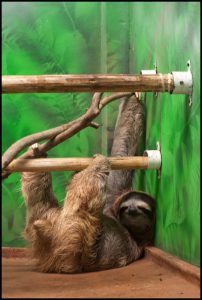
The bus pulls up to the Sanctuary gate and we climb off. Just past the main gate is a huge statue of the Giant Ground Sloth, which we learn is a life sized representation of a prehistoric breed of sloth that could be as big as an elephant. Otherwise, the sanctuary appears to be made up of 3 main buildings on a large reserve, including a lecture hall, a nursery and the reception/cafeteria/gift shop building. Heading to reception, we purchase our tickets and are told a tour has just started and we should go to the lecture hall, knock on the door and ask to join. We scurry over to the hall, knock on the door and our guide lets us in. It’s an intimate tour today, just us and one other family with two young girls. After a quick introduction our guide goes on to tell us a little about the Sanctuary’s work before introducing us to the sloths who live in this room.
The Sanctuary got started in 1991 when its founders Judy and Louis Arroyo, who were running a hotel at the time, were brought an orphaned, three toed baby sloth by neighbourhood kids. They called the San Jose Zoo for help but were told that the zoo had no idea how to care for sloths. Another rescue centre they contacted on the West Coast said the same thing. So they did their best to care for the sloth, feeding her the leaves that the wild sloths in the forest ate. That sloth was Buttercup, who is the Sanctuary’s ambassador today. Two years after Buttercup’s arrival a local bus driver brought them another orphaned infant sloth. Once word got out that they knew what they were doing it snowballed from there. Since then they have learned a lot and have rescued over 500 sloths, 149 of which are permanent residents and 9 of which are infants. Most of the permanent residents were infants when they arrived and without their mothers care and teaching are unprepared for life in the forest. At this time no one knows enough about sloth behaviour in the wild to teach them what they need to know to live in the forest. The other Sanctuary residents are physically unable to survive in the wild due to loss of vision, amputations or injures to hands and feet from high tension wires.
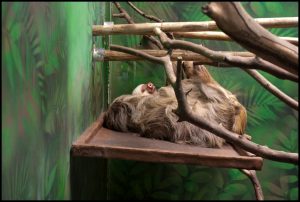
Sloths are mostly nocturnal mammals who use their claws to hang on to branches while they feast on leaves. Their long claws (3 to 4 inches), which are actually made of bone and capable of regeneration, make walking on the ground difficult so they spend all of their time up in the trees, coming down only once a week to go to the bathroom.
There are two categories of sloth, the two toed sloth which is slightly bigger and more distinctly nocturnal than the three toed sloth; although they otherwise share many of the same characteristics. The tough leaves in a sloth’s diet are difficult to digest so they have a specialized, four part stomach with symbiotic bacteria; all of which means that it can take up to one month to digest a meal. Their leafy diet isn’t terribly nutritious and they don’t get much energy from it, which is why they conserve their energy by moving slowly; although they can move quite quickly when necessary. They are also noted to be excellent swimmers, with a very natural breaststroke.
Our guide introduces us to the sloths in the room. There is Toyota, a three toed sloth who got shocked by a power line, fell to the ground and had vultures and maggots eating at his injured arm for several days (which actually saved him as it kept the gangrene from spreading) before he was rescued. The Sanctuary had to amputate his arm. They didn’t know much about anesthetizing a sloth at the time and so had to guess at the dosage. When Toyota finally awoke two days later he recovered quickly, eating and being his easy going self; and was given the name Toyota for his noted durability. (In Costa Rica, Toyotas are considered one of the more durable cars available.) As his story is told Toyota looks up at us, covering his eyes at the more gruesome parts of the tale, almost as if he can understand the story being told and is embarrassed by the attention. Unfortunately he can’t be set free as a sloth can’t effectively climb with three limbs, so he’s now a permanent resident of the Sanctuary.
When sloths are young they reside with their mother for a few years, where they learn all the essential jungle survival skills, before their mother starts to push them away and eventually sends them out on their own. From there on out they are solitary creatures. Unfortunately, if a baby falls from the tree during the crucial first year the mother will generally not go down and rescue it. She will not waste her energy on what is likely a disabled infant; and this is how the sanctuary ends up with these infants.
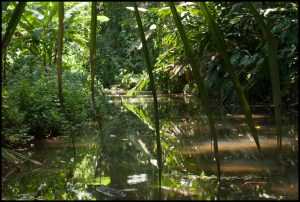
But nature is flexible and sometimes things work out a bit differently. Case in point, Johnny Depp and Taz, a pair of two toed sloths (one male and one female) who are cuddling in a nearby enclosure. They were both orphaned as infants and came in to the sanctuary at the same time. Despite having been together for nine years, they will not mate. The reason being that as infants they bonded with each other and each assumed the other was its mother. Since both are waiting to be pushed away by their mother – and neither one will assume the parental role – they are utterly bonded to each other. They look blissful wrapped up in each others lanky arms.
Next we move on to the nursery, which is an open aired building with about 10 or so cages. On each cage is a card noting the infant sloth’s name (each incoming sloth is given a name by the sanctuary founder Judy), date of arrival and how it ended up here. Inside the cages the baby sloths are half awake, hugging their blankets and stuffies, which they apparently find very comforting. We’re not allowed to get too close as that would be distressing for them.
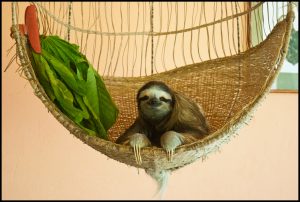
We bid our guide farewell and are lead down to the water for a one hour canoe ride through the bayous of the Estrella River Delta. We climb into the boat with three other tourists and set off. Our boat guide sits at the back and uses his oar to propel and guide the boat. We glide through the water soundlessly, out through the marshy jungle, past bamboo forests and banana trees heavily laden with fruit. Howler monkeys shriek in the canopy overhead and swing from one tree to the next, always just out of camera range. The water is low at one point and we get stuck and all have to push or pull whatever we can grab along the muddy shoreline to break the boat free. While we do not see any wild sloths along the way (which is the hope) but our boat guide points out all kinds of creatures, including fiddler crabs who peer out of their holes along the river, a common basilisk lizard who runs across the water, some turtles sunning themselves in the shallows and a caiman who eyes us warily from the water’s edge.
Boat tour complete, we climb out of the boat and head up to the gloriously air conditioned gift shop where we browse awhile before heading outside to meet the aforementioned Buttercup, sitting in her hanging chair near the cafeteria. She gives us a knowing look as we arrive and proceeds to put on a graceful display of slow moving acrobatics, all while languidly toying with her leafy snack. She is a magnificent poser and I can’t help but be struck by the intelligence and presence I see in those eyes.
Sloths are pretty cool creatures and I am so glad that they have this Sanctuary to care for their most vulnerable members.


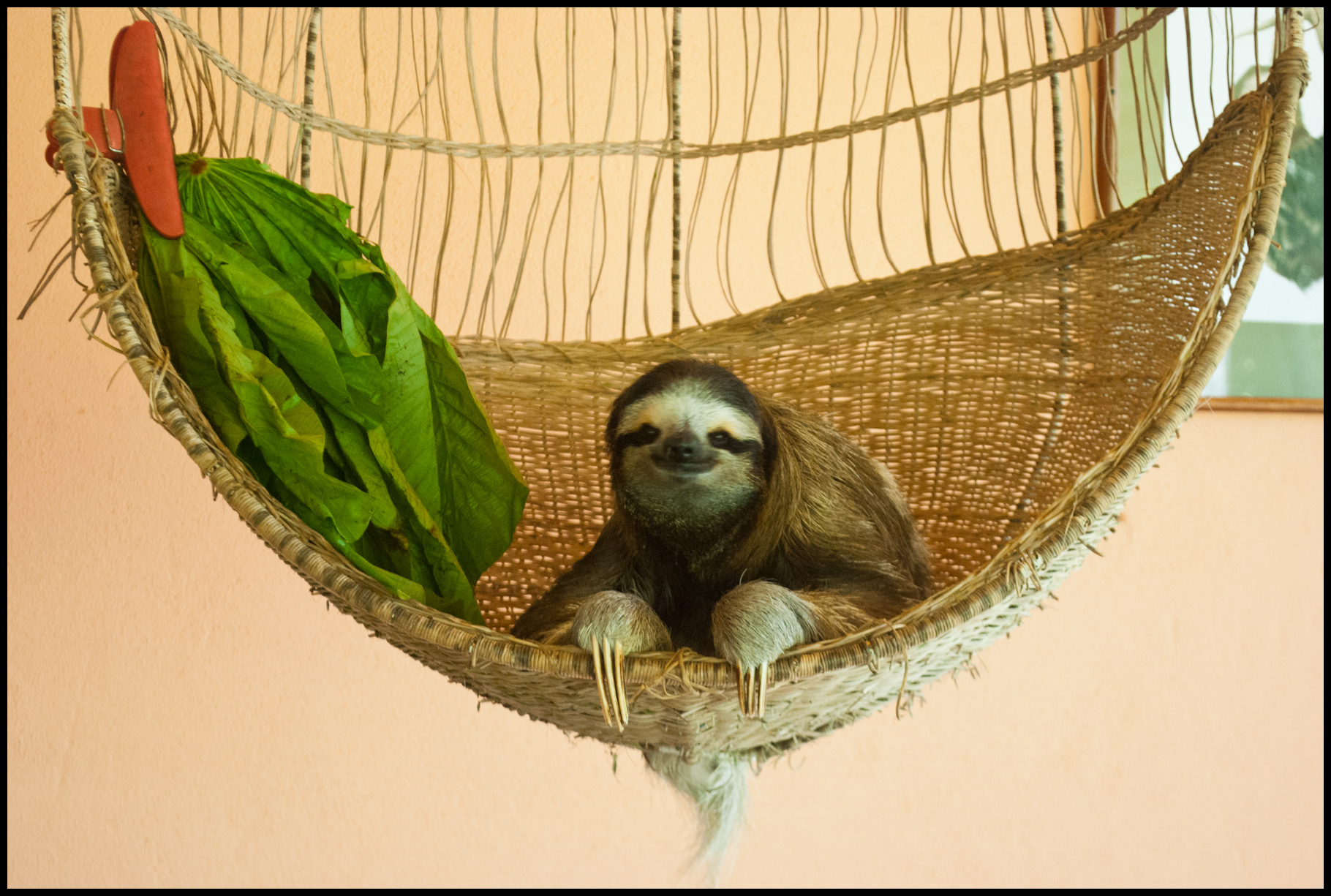
Pumpkin Spice Latte « Never Done That!
2014/10/26 at 7:51 pm[…] about it. You’ll get to the point where you just want a drink. Not every week can be sloth sanctuaries or sensory deprivation float […]